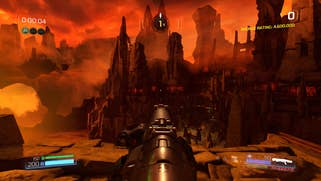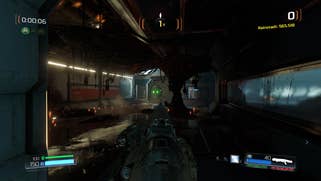Doom's new 4K patch analysed on Xbox One X and PS4 Pro
Image quality improves, but what about performance?
Last week, Bethesda and id software released a brand new '4K resolution' patch for the brilliant Doom 2016 reboot, promising improved image quality for PlayStation 4 Pro and Xbox One X. Resolutions are certainly increased, but there has been some talk that performance has suffered as a result. Our tests suggest that this is indeed the case, but work carried out on the id Tech 6-powered Wolfenstein: The New Colossus may suggest a possible solution.
But to begin with, we do have to take issue with the description of this upgrade as a '4K resolution' patch. There are parallels here with Wolfenstein - just like its id Tech 6 companion, Doom on PlayStation 4 Pro renders at a maximum 2560x1440, with only Xbox One X that's capable of hitting native 3840x2160, and even then only in select circumstances. Both systems (and indeed both games) render with dynamic resolution scaling, in order to get a closer lock to their target 60 frames per second performance level, effectively trading pixels for frames for smoother gameplay.
Actual pixel counts fluctuate significantly, but Xbox One X holds up pretty well overall and the most common resolution we found in Doom is 3072x2160. The scaler can drop horizontal pixel count only, or it can scale in both directions, depending on load. We've seen Doom on Xbox One X drop to 2880x1620 (a 75 per cent scaling on both axes) but it can actually drop even lower than that. For its part, PS4 Pro scales horizontally only, and we've seen the game drop frequently to 2176x1440. At their lowest points, Xbox One X pushes 25 per cent more pixels than the Pro, but the gap in average gameplay rises to a circa 2x increase in resolution in favour of the Microsoft platform.
So what does this mean for image quality? Both systems offer an increase in overall clarity compared to the pre-patch versions of the game, but clearly Xbox One X appears sharper and cleaner overall because of its additional GPU grunt. On Xbox One X, the resolution is higher enough that it looks convincingly 4K much of the time while PS4 Pro feels like a minor upgrade, but this is never going to be a razor-sharp experience, as Doom's aesthetic focuses more on post-processing. However, the most important aspect to discuss here is performance and this is where things become a little tricky. Prior to this patch, both consoles were able to deliver a near-flawless locked 60 frames per second experience at 1080p (via PS4 Pro boost mode or X's back-compat implementation) but things have changed.
With Xbox One X, the average combat sequence still manages to feel very responsive while delivering mostly stable performance, with only a handful of dropped frames popping up from time to time. These minor drops are nearly imperceptible during actual gameplay since there are relatively few of them and motion blur helps to hide the judder. However, scenes with a lot of enemies and on-screen objects can see a harder hit to performance, further exacerbated by the full screen depth of field blur used during glory kills. It seems likely then that the adaptive resolution feature isn't as aggressive as it could be and falters in select sequences such as this.
Although a little less stable overall, PlayStation 4 Pro acts much like Xbox One X, but the issue it has is that the depth of field effect used by the glory kills has even more of a profound impact on performance. Now, on one hand, these kills only last a short time and are not fully interactive and thus control is not compromised - honestly, they serve as a nice momentary breather during hectic battles. On the other hand, this does detract from the fluidity of the presentation.
All of which brings us back to Wolfenstein: The New Colossus - a game that also suffered badly at launch from some pretty severe frame drops from the target 60 frames per second. At the end of last year, a new patch was deployed that included the ability to employ a more aggressive form of dynamic resolution scaling. In short, the scaler could drop to lower pixel counts in order to smooth off the action and to get much, much closer to a locked 60fps.








You lose some clarity, but it greatly improves the fluidity and feel of the game, and it works just as well on both PlayStation 4 Pro and Xbox One X. The results suggest that perhaps taking a more aggressive approach to dynamic scaling would help alleviate the remaining performance issues in this new Doom patch. To put it simply: on PS4 Pro, aggressive scaling allows the visually more complex Wolfenstein 2 to run smoother than the patched Doom.
Still, despite the metrics and graphs you'll see in the video embedded above, Doom still manages to feel smoother than you might expect, and the overall experience is overwhelmingly 60 frames per second. Loading it up again reminded me just how good this game looks in motion - especially on Xbox One X. Wolfenstein: The New Colossus is similarly beautiful to behold and its last patch managed to greatly improve the performance situation present at launch. It also serves as an interesting example of how simple options can allow users to tweak the experience to their liking. Those that prefer a more stable frame-rate have that option while others that favour image quality can go down that route. Indeed, it's possible to completely turn off the scaling solution altogether in Wolfenstein 2, although we don't recommend it.
With that in mind, perhaps Doom can be updated once more to allow additional control for users that demand smoother performance? Wolfenstein has demonstrated that id has the tools available to get the job done, and it would be icing on the cake for what remains a really special game.










